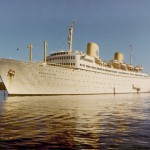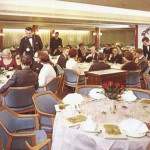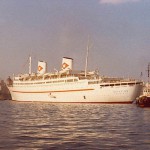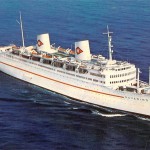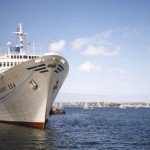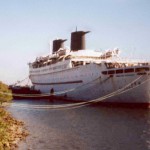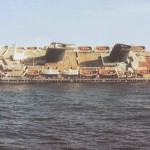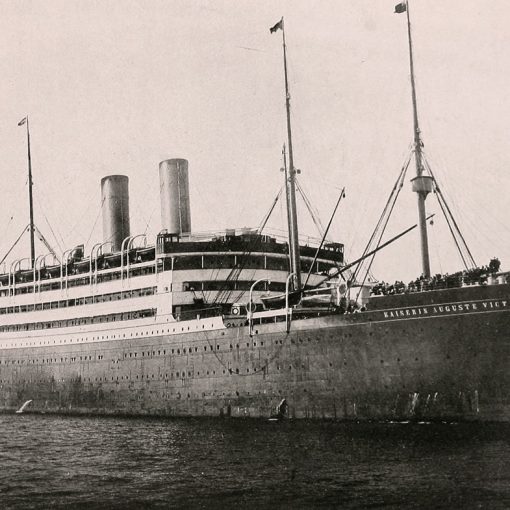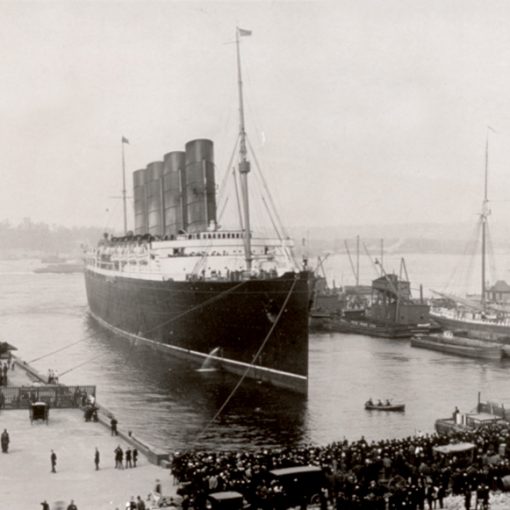1957 – 2001
Also known as Navarino and Regent Sea
In 1915 the Svenska Amerika Linien (the Swedish American Line), or SAL, started business when they bought the Dutch steamer Potsdam and converted her into their magnificent pioneer liner Stockholm. The company enjoyed immediate success, but as the Swedish emigration was about to end, the line never took full advantage of it. SAL became specialised in tourism – Swedish society and Swedish-Americans wanting to visit the old country.
In 1920, SAL bought the Canadian Pacific liner Virginian and turned her into the Stockholm’s running mate Drottningholm. A few years later the Swedish American Line felt it was time to create new liners for themselves instead of merely buying finished ones. Between 1925 and 1928 the two fantastic 20,000 ton liners Gripsholm and Kungsholm entered service. They proved immense successes, not least in World War II when they served the Allied with distinction.
After the war, SAL realised it was time for a renewal in the company’s fleet. In 1947, the Kungsholm was sold to Home Lines who renamed her Italia, and already by the early Fifties, a new Kungsholm was on the drawing boards. She would be designed as an almost pure cruise ship sporting a heat resisting white hull as livery instead of the conventional liner-black. Just as her predecessors, the second Kungsholm became a success on the world’s oceans.
In 1954 the old Gripsholm was considered old enough to be sold to Norddeutscher Lloyd, becoming their first ship to enter the Atlantic after the war, renamed Berlin. With only two passenger ships in service after the Gripsholm’s withdrawal, SAL urgently needed a new, large liner to team with the new Kungsholm.
The order came in late 1955 to the Ansaldo shipyards in Genoa, Italy – the same shipyard that had built the famous Andrea Doria and Cristoforo Colombo. The Kungsholm was 21,000 gross tons large, and the new ‘sister’ would be somewhat larger with an estimated tonnage of 23,000. This figure would make the new ship the largest in SAL’s history.
On April 8, 1956 the new liner was launched and christened Gripsholm after her predecessor. Shortly afterwards she had her engines fitted – they were Götaverken Diesels with power enough to give the ship a moderate service speed of 18 knots. As construction advanced, you could see how the grace of the Gripsholm slowly grew. Just like her older running mate Kungsholm, she would be entirely white, except for the two exquisite yellow funnels with the distinguished blue circle adorned with three crowns. The shape of the hull was sleek with a very slanting bow and a perfectly rounded stern. The Swedish certainly had a sense of proportion.
The maiden voyage of the Gripsholm took place on May 14, 1957. She sailed on the now very established route between Göteborg and New York. When she reached New York she received a cordial welcome from the city’s harbour, with spraying fire boats and cheering crowds.
The interiors on the Gripsholm were divided into two classes on conventional Atlantic crossings. However, these two classes did not have many differences because on cruises they were merged into one class. On a trans-Atlantic crossing she had place for 778 passengers while the cruise passengers had it more spacious with as limit of just 440 people.
The planning of passenger areas were done meticulously. All the group passenger facilities were on the Gripsholm situated on one deck – the Veranda Deck. At the foremost part of the superstructure the forward saloon with its breathtaking sea-view was situated. You had access from the forward lobby to the smoking room through a set of glass doors, framed with copper plaques. On an Atlantic crossing, the smoking room was reserved to the first class passengers. Lighting up a cigarette, you could enjoy the room’s fabulous decorations such as a large stone relief entitled ‘Symfonica’ created by artist Gunnar Nylund.
The Main Lounge had an impressive size of 480 square metres. The magnificent room was decorated with an artwork called ‘School of Fish’ by ceramist Carl Harry Stålhane. The ship’s dining rooms surrounded the kitchen and could be divided into three different rooms for special parties and such. Another very popular feature was the swimming pool. During a cruise it always seemed to be filled even if stormy weather made the waves in the pool exceed the outside ones.
With the Gripsholm, several luxury cruises were made such as around the world, to the Pacific, around South America, to the Mediterranean, to the North Cape, into the Baltic Sea and into the Caribbean.
In 1964, the Kungsholm was sold to Norddeutscher Lloyd who renamed her Europa. Once again, SAL only had one ship in service. By 1966 they had put a new 26,000 gross ton Kungsholm in service alongside with the Gripsholm. To meet the standards of her new running mate, the Gripsholm was refitted and emerged with slightly larger gross tonnage of 23,216. In 1972, Gripsholm was once again refitted and emerged with only 22,725 gross tons.
Three years later, in 1975, the Svenska Amerika Linien decided to shut down their passenger liner business. The executive office in Göteborg expected a massive economic loss and diminishing sales within the near future. The two liners in service – the Gripsholm and the Kungsholm – was both sold to foreign interests. The Kungsholm was sold to Flagship Cruises and soon hoisted the Liberian flag. Gripsholm was sold to Karageorgis Lines and would within short sport the Greek flag. The ship was renamed Navarino and during the conversion for the new company, she was given a new lido deck, a new forward observation deck and many additional cabins. The total passenger capacity was set at 650 people.
On May 22, 1976, the Navarino went out on her premier cruise for the Karageorgis Lines, which would be around the Mediterranean departing from Venice. By this time the gross tonnage was down to 17,392. The Navarino continued her cruises for Karageoris Lines until 1981 when the ship was grounded off Patmos. As she was severely damaged, she was to be sold to the Sally Shipping’s Commodore Cruises division who intended to sail her after she had been repaired. However, during the repair, a violent fire broke out and destroyed much of the passenger accommodation. In addition to this, the dry-dock collapsed and caused further damages. The old Gripsholm was laid up in 1982 after a difficult salvage operation performed by Neptun Transport & Marine Services in co-operation with the Swedish Roda AB based at the ship’s old homeport in Göteborg.
After the operation, Sally Shipping withdrew from the purchase, and the ship was instead bought by the Rome-based company Multiship Italia in 1983. They renamed the vessel Samantha but she would never sail as such because already in 1984 she was resold to the newly formed Regency Cruises who renamed her Regent Sea. She entered service for her new company in November 1985 with newly finned funnels. Luckily, she escaped the indignity of having one of her funnels removed as the Kungsholm had had in 1978. The clean lines and proportions of the former Gripsholm remained.
For the next ten years the Regent Sea continued to cruise the oceans without any major mishaps except for two crewmen who died during a boat drill in 1990. However in 1995, Regency Cruises went bankrupt and the ship was laid up at Freeport. In 1997 she was auctioned off to the United States American Cruise Line. The shortened her name to just Sea and intended to convert her into a casino ship America. The new owners started off with gutting the Sun and Veranda Decks. When they suddenly ran out of money the conversion was abruptly halted. From then on, the old Gripsholm remained at her lonely cruise ship berth in Tampa, awaiting an uncertain future.
But, in the spring of 2001, all hopes suddenly faded when the Sea was sold to Indian shipbreakers, and she left Tampa under tow a short time later. However, the old Gripsholm’s last voyage would be quite an eventful one. Off the coast of Dakar, she was boarded by pirates who pillaged some of the remaining items on board. Considered as no major incident, the voyage to India continued nevertheless. But all of a sudden, a small lining of hope appeared.
As a significant part of Swedish maritime history, efforts were being made in Stockholm to purchase the ship and restore her as a floating hotel in the city’s harbour. However, the city council delayed the decision and harbour residents protested, since they didn’t want their sea view spoiled by a permanently anchored liner. Before anything could come to pass, fate would seal the Sea’s destiny once and for all.
On July 6th, 2001, the ship encountered heavy seas off the coast of South Africa. Requesting refuge in the sheltered waters of Algoa Bay, she was denied permission for fear of oil leakage. Instead, she was left to battle the storm under tow. Conditions worsened, and the ship eventually took on a 30-degree list to starboard and started taking on water. Finally, at 5 am on July 12th, the old Gripsholm slipped beneath the waves 83 miles South-Southwest of the Cape of Good Hope, at a depth of approximately 4,200 meters. In a sort of poetic conclusion, the ship had avoided the undignified end of the blow torches.
Specifications
- 631 feet (192.7 m) long
- 82 feet (25 m) wide
- 23,191 gross tons
- Götaverken diesels powering two propellers
- 18 knot service speed
- Passenger capacity of 778 people on trans-Atlantic service, 440 people on cruises

